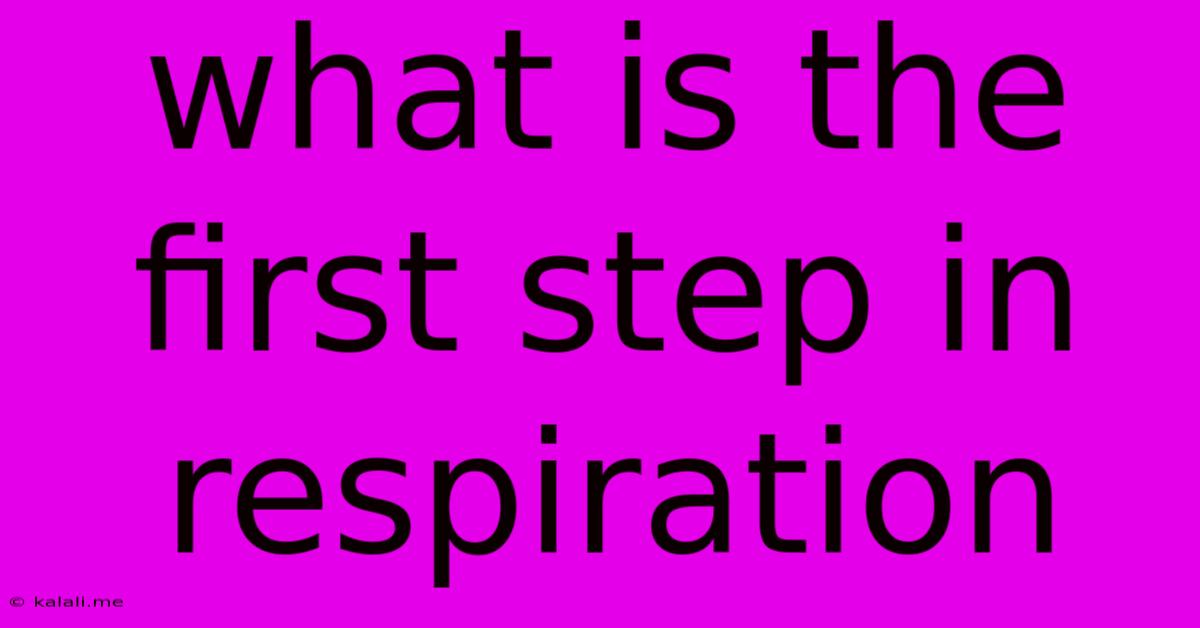What Is The First Step In Respiration
Kalali
Jun 14, 2025 · 3 min read

Table of Contents
What is the First Step in Respiration? Unlocking the Secrets of Cellular Energy Production
The first step in respiration, the process by which cells break down glucose to generate energy, is glycolysis. This crucial initial phase lays the foundation for the subsequent stages of cellular respiration, ultimately yielding the ATP (adenosine triphosphate) that fuels all cellular activities. Understanding glycolysis is key to grasping the entire energy production pathway within our cells. This article will delve into the intricacies of glycolysis, explaining its location, reactants, products, and overall significance in the broader context of respiration.
What is Glycolysis? A Detailed Breakdown
Glycolysis, literally meaning "sugar splitting," is an anaerobic process – meaning it doesn't require oxygen – that occurs in the cytoplasm of cells. It's a remarkably conserved pathway, meaning it's nearly identical across a vast range of organisms, from bacteria to humans. This fundamental metabolic process involves a series of ten enzyme-catalyzed reactions that convert one molecule of glucose (a six-carbon sugar) into two molecules of pyruvate (a three-carbon compound).
The Key Players and Steps:
While a full biochemical description of the ten steps is beyond the scope of this introductory article, here's a simplified overview:
-
Energy Investment Phase: The first five steps require an investment of energy in the form of two ATP molecules. These ATP molecules are used to phosphorylate glucose, making it more reactive.
-
Energy Payoff Phase: The remaining five steps yield a net gain of four ATP molecules and two NADH molecules. NADH is a crucial electron carrier that plays a vital role in subsequent stages of respiration.
Net Products of Glycolysis:
After the ten steps are completed, the net yield of glycolysis from a single glucose molecule includes:
- 2 ATP molecules: These are the usable energy currency of the cell.
- 2 NADH molecules: These electron carriers transport high-energy electrons to the electron transport chain (ETC), a later stage in cellular respiration.
- 2 Pyruvate molecules: These three-carbon molecules are the starting materials for the next stage of respiration, either fermentation (in the absence of oxygen) or the Krebs cycle (in the presence of oxygen).
Glycolysis: The Foundation of Energy Production
Glycolysis is not only the first step in respiration but also a pivotal metabolic pathway with far-reaching implications. Its products, ATP and NADH, are essential for numerous cellular processes. Moreover, the pyruvate produced can feed into other metabolic pathways, highlighting its central role in cellular metabolism. The efficiency of glycolysis directly impacts the overall energy production capacity of the cell.
Beyond Glycolysis: The Next Steps in Respiration
Following glycolysis, the fate of pyruvate depends on the presence or absence of oxygen. In aerobic respiration (in the presence of oxygen), pyruvate enters the mitochondria and proceeds to the Krebs cycle and oxidative phosphorylation (the electron transport chain). In anaerobic respiration (in the absence of oxygen), pyruvate undergoes fermentation, producing either lactic acid (in animals) or ethanol and carbon dioxide (in yeast).
In conclusion, glycolysis is undeniably the first and crucial step in respiration, setting the stage for efficient energy production within the cell. Understanding its intricacies is fundamental to appreciating the complexity and elegance of cellular metabolism.
Latest Posts
Latest Posts
-
The Most Common Site For Taking A Pulse Is The
Jun 15, 2025
-
Dc To Ac Power Inverter Circuit
Jun 15, 2025
-
What Is The Square Of 65
Jun 15, 2025
-
Lines Of Symmetry In A Parallelogram
Jun 15, 2025
-
Which Of The Following Is Not Part Of Effective Communication
Jun 15, 2025
Related Post
Thank you for visiting our website which covers about What Is The First Step In Respiration . We hope the information provided has been useful to you. Feel free to contact us if you have any questions or need further assistance. See you next time and don't miss to bookmark.